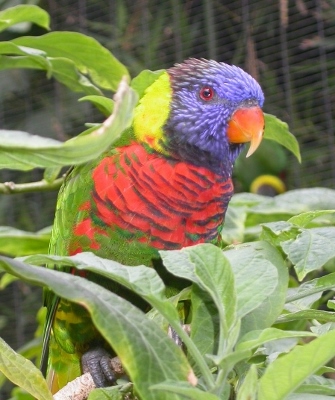
October is almost at its end, so our time with the rainbow lorikeet as our Animal of the Month is also coming to an end. We hope you followed us @ExoticPetVets and enjoyed our tweets about these brilliantly colourful and smart birds. If you missed any, here is a summary. Did you know?:
- The rainbow lorikeet, or lory, (Trichoglossus moluccanus) is a species of medium-sized parrot.
- There are about 30 subspecies of rainbow lories, which are native to Australia’s eastern seaboard.
- Rainbow lories have been introduced to other parts of Australia, New Zealand and Hong Kong.
- In New Zealand, feral rainbow lories compete with native bird species for resources and their capture is encouraged.
- Based on their name, it’s no surprise rainbow lories have colourful plumage, which includes blue, green, yellow and red.
- It’s hard to tell the gender of rainbow lories by sight as there are few obvious differences between males and females.
- Rainbow lories are monogamous birds and mate for life.
- In the wild, rainbow lories are arboreal and live in forests, eucalyptus groves and mangroves.
- Rainbow lories live a nomadic life and follow the eucalyptus tree flowering season along Australia’s coastline.
- As they are social birds, rainbow lories are usually seen travelling in pairs or flocks.
- Rainbow lories can feed in flock sizes ranging from fewer than 50 birds to more than 1,000.
- In the wild, rainbow lories can be aggressive with other birds who are competing for the same food and nest resources.
- The rainbow lory diet in the wild consists of nectar, pollen, fruits, berries, and blossoms.
- Because they eat soft food & liquids, rainbow lories have tiny hair-like appendages (papillae) on the end of their tongues.
- The papillae are brush-like bristles and allow rainbow lories to collect pollen and soak up nectar.
- The Trichoglossus part of rainbow lories’ scientific name is derived from Ancient Greek. Tricho = hair. Glossa = tongue.
- In captivity, rainbow lories can eat commercial nectar and pollen substitutes.
- Rainbow lories eat a lot and have a relatively short digestive tract, which means frequent droppings.
- Because of the high moisture content of their diet, rainbow lories will produce loose and projectile droppings.
- Rainbow lories are smart, sassy and loud but are not known for their ability to mimic human speech.
- In captivity rainbow lories can get bored and need a large cage or play area so they can hop and play with bird safe toys.
- Rainbow lories are hardy birds and can live 10 – 15 years with proper care in captivity.
- Good hygiene is vital to the health and longevity of rainbow lories in captivity.
- Cages and play areas for captive rainbow lories must be kept clean. Uneaten food must be removed daily or it will spoil.

